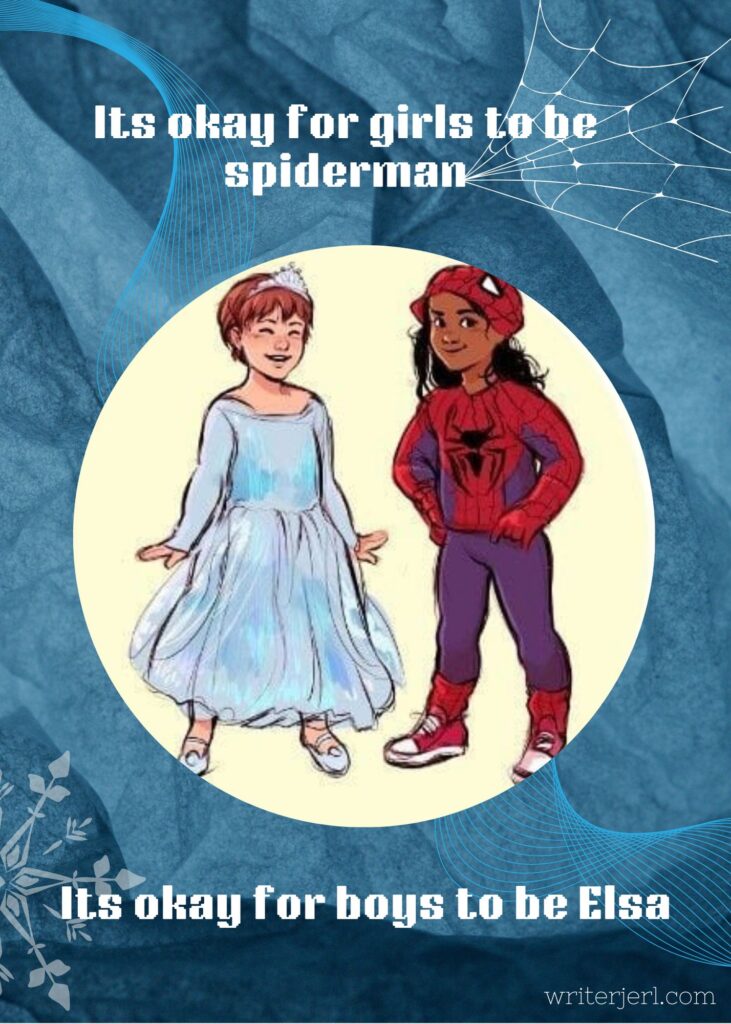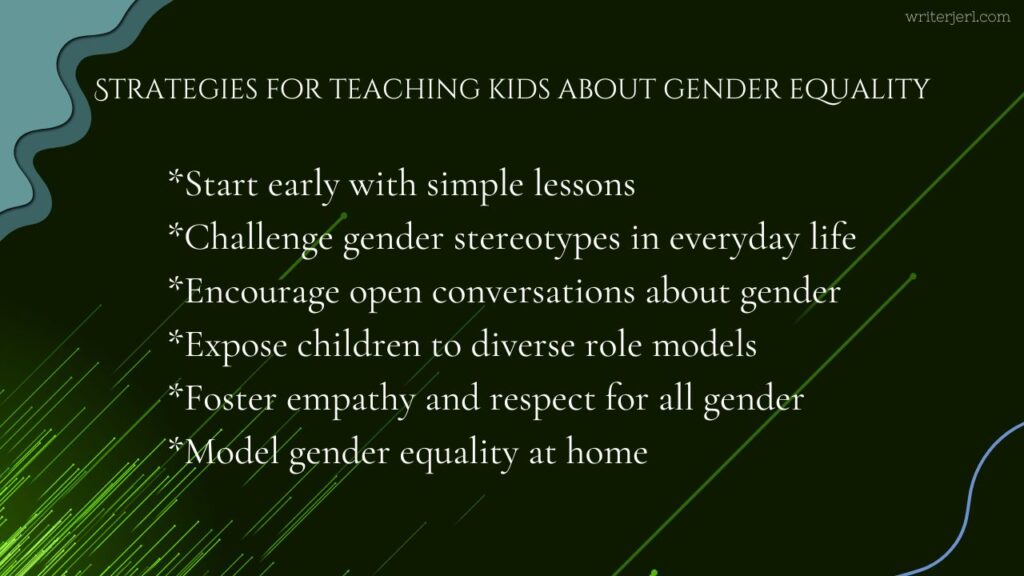Introduction
In today’s interconnected world, teaching children about gender equality is more important than ever. As societies around the globe try to ensure equal rights and opportunities for all, parents, educators, and caregivers play a crucial role in shaping the minds of the next generation. Gender equality isn’t just about creating equal opportunities for men and women, it’s about ensuring that every child, regardless of their gender, grows up feeling empowered to pursue their passions and live a life free from discrimination.
This blog post provides a comprehensive guide for teaching kids about gender equality, addressing common gender stereotypes, and encouraging them to become empathetic and respectful individuals. Whether you’re in India, Europe, Africa, the Americas, or any other part of the world, these strategies can be adapted to your specific cultural context.
Start early with simple lessons
Children form their understanding of the world from an early age, and their views on gender are no different. By the time kids are toddlers, they are already observing and internalizing gender roles from their environment, such as through toys, family interactions, and media. It’s important to start teaching the concepts of gender equality early on.
Use toys and play to break down gender stereotypes
Many toys are marketed specifically to boys or girls, reinforcing traditional gender roles, think dolls for girls and cars or action figures for boys. To promote gender equality, offer your child a variety of toys that aren’t limited by these traditional ideas. Encourage boys to play with dolls and kitchens and girls to play with construction sets and superheroes. By normalizing gender-neutral play, you help your child understand that their interests are not restricted by their gender.
Examples around the world
In Sweden, gender-neutral play is encouraged in many preschools, where children are exposed to a wide range of toys regardless of their gender. This approach can help dismantle gender stereotypes from an early age and allow children to develop broader interests.

Challenge gender stereotypes in everyday life
Stereotypes about gender roles are deeply embedded in many cultures and are often reinforced through media, family traditions, and even educational systems. One of the most important steps in teaching kids about gender equality is to consistently challenge these stereotypes in everyday situations.
Discuss gender stereotypes when they arise
Whether it’s a TV commercial showing only women cooking or a cartoon where the hero is always male, gender stereotypes are all around us. When you come across these, talk to your child about them. Ask questions like, “Why do you think only the girl is shown doing the laundry?” or “Do you think boys can also become ballet dancers?” By engaging in these conversations, you’re teaching your child to recognize and question gender norms, rather than accept them as facts.
Encourage shared responsibilities at home
Household chores are often divided along gender lines, with women typically taking care of cooking, cleaning, and childcare, while men handle outdoor tasks or finances. By involving children in all types of tasks regardless of gender, you show that these responsibilities are not defined by one’s sex.
Global perspectives on shared responsibilities
In Scandinavian countries, there has been a cultural shift toward shared parenting and equal household responsibilities. This is supported by generous parental leave policies that allow both mothers and fathers to take time off to care for their children, setting an example of equality for the next generation.
Encourage open conversations about gender
It’s vital to create an environment where children feel comfortable asking questions and discussing topics related to gender. Whether your child asks, “Why can’t boys wear dresses?” or “Why do girls cry more than boys?” it’s important to engage in these discussions with an open mind.
Answer gender questions honestly and thoughtfully
When kids ask questions about gender, they’re trying to make sense of the world around them. Be open to these conversations and explain that different people may have different ideas about what it means to be a boy or a girl, but everyone has the right to express themselves in ways that make them feel comfortable.
Address misconceptions and prejudice
If your child expresses gender-based prejudice, such as “girls can’t play football” or “boys don’t cry,” gently correct them by explaining that these are stereotypes, not facts. Encourage empathy by helping them imagine how it might feel to be told they couldn’t do something just because of their gender.
Expose children to diverse role models
Kids are heavily influenced by the people they see around them, including parents, teachers, and public figures. Ensuring that your child is exposed to a wide range of role models across different genders, professions, and backgrounds helps broaden their understanding of what is possible for everyone, regardless of gender.
Read books and watch shows that promote gender equality
There are many books and TV shows now available that highlight strong female characters and empathetic male figures, or that feature characters who don’t conform to traditional gender roles. Look for media that showcases a diversity of roles for boys, girls, and non-binary characters.
Introduce positive global role models
From global political leaders like New Zealand’s Jacinda Ardern and Germany’s Angela Merkel to athletes like Serena Williams and Lionel Messi, there are countless role models from different fields who embody the principles of gender equality. Highlight their accomplishments and contributions, and make it clear that their success is due to their talent and determination, not their gender.

Foster empathy and respect for all genders
One of the core principles of gender equality is respect for all individuals, regardless of their gender. It’s important to teach children empathy and compassion for others who may experience discrimination or unfair treatment.
Teach empathy through role play
One effective way to build empathy is through role play. For instance, you could play a game where your child imagines how a girl feels when she is told she can’t play a sport because she’s a girl, or how a boy might feel if he’s told he can’t express his emotions. These activities help children develop emotional intelligence and understand the negative impact of gender-based discrimination.
Discuss real-world examples of gender discrimination
As your child grows older, you can begin to introduce more complex discussions about gender inequality. Talk to them about gender pay gaps, underrepresentation of women in leadership roles, or challenges faced by transgender individuals. Use age-appropriate language and encourage them to think critically about these issues.
Model gender equality at home
Children learn more from what they see than what they are told. If you want to teach gender equality, it’s essential to model these behaviors in your own life.
Share household and parenting duties equally
If children see their parents or caregivers dividing household chores and parenting responsibilities equally, they are more likely to understand that these duties are not gender-specific. Fathers should be as involved in nurturing, and mothers should be equally recognized for their professional contributions.
Model gender-inclusive language and attitudes
Be mindful of the language you use at home. Avoid reinforcing gender stereotypes with phrases like “boys will be boys” or “girls are more nurturing.” Instead, promote a culture of inclusion and respect for everyone, regardless of their gender.
Teach about intersectionality
Gender equality does not exist in a vacuum. It’s important to teach kids that gender intersects with other aspects of identity, such as race, class, sexuality, and disability, and that everyone’s experience with gender is different.
Explain that gender equality benefits everyone
Helping kids understand that gender equality is not just a women’s issue is key. It benefits all of society, including men. When both boys and girls are free from rigid expectations, they can express themselves more fully and contribute to a more just and equitable world.
Conclusion: Raising a gender-equal generation
Teaching kids about gender equality is an ongoing process that requires intentional actions, conversations, and examples. From challenging stereotypes and fostering empathy to encouraging open dialogue and modeling equality at home, every small step contributes to a more equitable future. As parents, caregivers, and educators, we have the power to raise a generation of children who respect and celebrate differences, and who will one day contribute to a world where all people regardless of their gender have equal opportunities to thrive. By adopting these strategies and tailoring them to your cultural context, you can help foster a global movement towards gender equality, one child at a time.